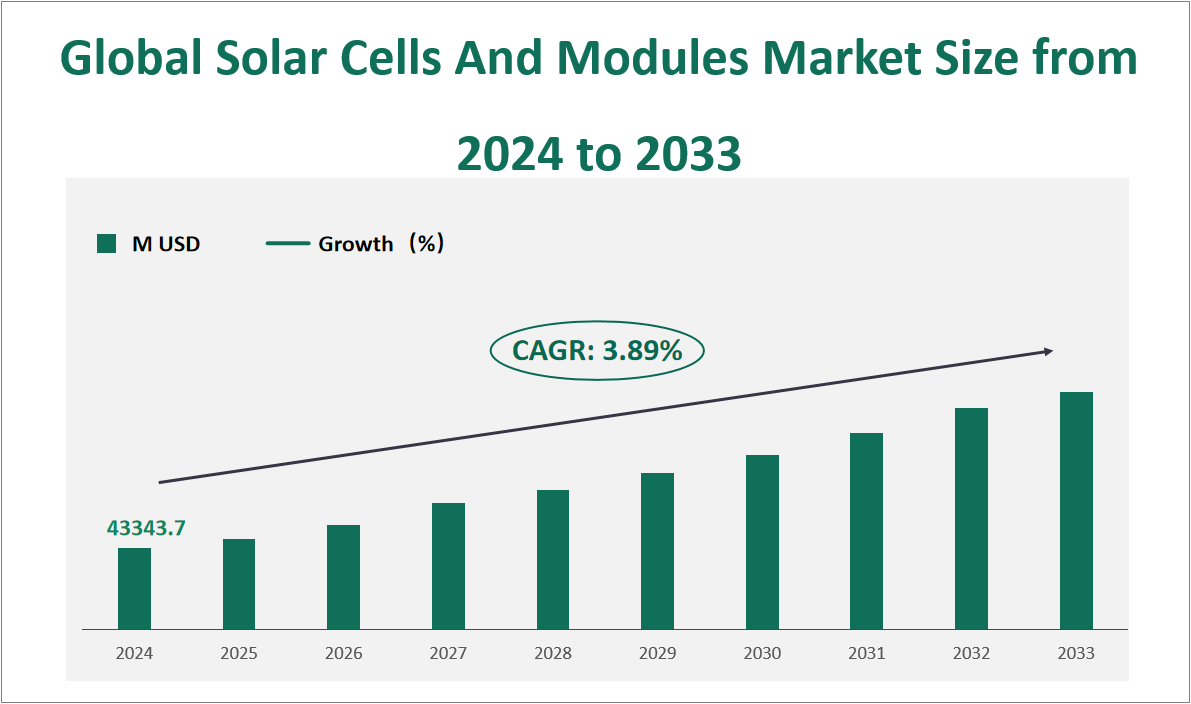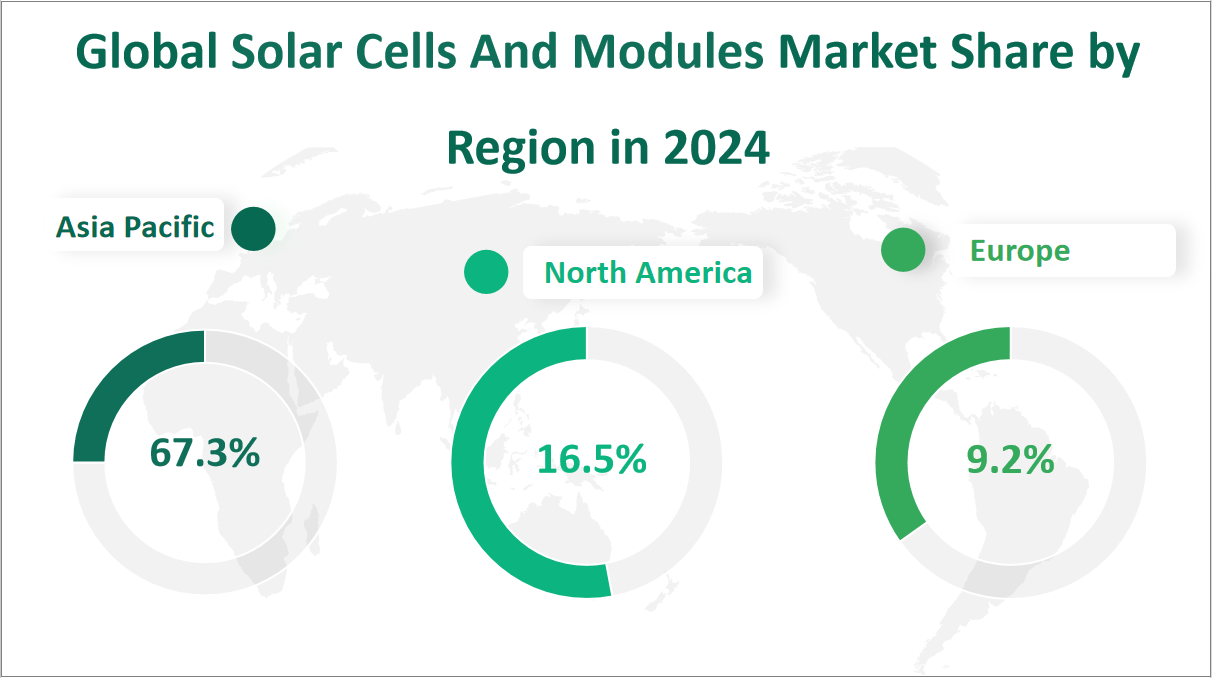1 Global Solar Cells And Modules Market Outlook
The global Solar Cells And Modules market is projected to exhibit substantial growth in the coming years, with a CAGR of 3.89% from 2024 to 2033, reaching a total market size of $43343.7 million USD in 2024. Solar cells, also known as photovoltaic (PV) cells, are semiconductor devices that convert sunlight directly into electricity. These cells are typically made from materials such as crystalline silicon (monocrystalline or polycrystalline) or thin-film materials like cadmium telluride (CdTe) and copper indium gallium selenide (CIGS). Solar modules, on the other hand, are assemblies of multiple solar cells connected in series or parallel to produce higher voltages and currents. These modules are designed to be durable, weather-resistant, and capable of generating electricity for residential, commercial, and utility-scale applications.
Figure Global Solar Cells And Modules Market Size and Growth Rate (2024-2033)

2 Solar Cells And Modules Market Growth Drivers and Constraints
Driving Factors:
Increasing Demand for Renewable Energy: The global shift towards renewable energy sources is a primary driver for the growth of the solar cells and modules market. Governments worldwide are implementing policies to reduce carbon emissions and promote clean energy, leading to increased adoption of solar power.
Technological Advancements: Continuous improvements in solar cell efficiency and manufacturing processes have reduced production costs and increased the overall viability of solar energy. Innovations such as PERC (Passivated Emitter and Rear Cell) technology and bifacial solar panels have enhanced energy output and reduced the cost per watt.
Government Incentives: Many countries offer subsidies, tax credits, and other incentives to encourage the installation of solar panels. These incentives make solar energy more affordable for residential and commercial consumers, driving market growth.
Declining Costs: The cost of solar modules has decreased significantly over the past decade, making solar power more competitive with traditional energy sources. Lower costs have led to increased demand, particularly in emerging markets.
Energy Independence: Countries are increasingly looking to diversify their energy sources to reduce dependence on imported fossil fuels. Solar energy provides a domestic, renewable source of power that enhances energy security.
Limiting Factors:
Intermittency: Solar power generation is dependent on sunlight, making it intermittent and less reliable than traditional energy sources. This requires the development of energy storage solutions and grid integration technologies to ensure a stable power supply.
High Initial Costs: Despite declining prices, the initial investment required for solar installations remains high. This can be a barrier for some consumers, particularly in developing countries with limited financial resources.
Land Requirements: Large-scale solar farms require significant amounts of land, which can be a constraint in densely populated areas or regions with limited available space.
Regulatory Challenges: The solar industry faces regulatory hurdles, including complex permitting processes and grid connection requirements. These challenges can slow down the deployment of solar projects.
Technological Barriers: While solar technology has improved, further advancements are needed to achieve higher efficiencies and lower costs. Research and development efforts must continue to address these challenges.
3 Solar Cells And Modules Market Innovations and M&A Activities
The solar cells and modules market is characterized by rapid technological innovation. Companies are constantly investing in research and development to improve the efficiency and durability of solar cells. For example, the development of PERC technology has significantly increased the efficiency of monocrystalline silicon cells. Additionally, bifacial solar panels, which can generate electricity from both sides, are becoming more popular due to their higher energy yields.
Another area of innovation is the development of thin-film solar cells, which are lightweight, flexible, and can be integrated into various surfaces, including building materials. This technology has the potential to revolutionize the solar industry by expanding the range of applications for solar power.
The solar industry has seen significant consolidation through mergers and acquisitions. Major players are acquiring smaller companies to expand their product portfolios, enhance their technological capabilities, and achieve economies of scale. For example, Jinko Solar has expanded its global presence through strategic acquisitions and partnerships, allowing it to strengthen its market position and improve its supply chain efficiency.
Mergers and acquisitions also help companies to enter new markets and gain access to emerging technologies. This trend is expected to continue as the solar industry matures and companies seek to stay competitive in a rapidly evolving market.
The solar cells and modules market is also influenced by macroeconomic factors, government policies, and global trends in energy consumption. The increasing focus on sustainability and environmental protection is driving the adoption of solar energy worldwide. Additionally, the development of energy storage solutions, such as batteries, is crucial for addressing the intermittency of solar power and ensuring a stable energy supply.
4 Global Solar Cells And Modules Market Analysis by Type
In 2024, the global Solar Cells and Modules market is forecasted to have a total value of $43,343.7 million USD. At the product type level, Single Crystal Silicon is expected to dominate with a market value of $23809.5 million USD, representing approximately 54.93% of the total market share. Polycrystalline Silicon is projected to have a value of $15396.1 million USD, accounting for 35.52% of the market. The remaining segment, Others, is expected to contribute $2745.4 million USD, or 6.35% of the total market value. This indicates a continued preference for Single Crystal Silicon products, driven by their higher efficiency and growing demand in both residential and utility-scale applications.
Table Global Solar Cells And Modules Market Size and Share by Type in 2024
Type | Market Size in 2024 (M USD) | Market Share in 2024 (%) |
|---|---|---|
Single Crystal Silicon | 23809.5 | 54.93% |
Polycrystalline Silicon | 15396.1 | 35.52% |
Others | 2745.4 | 6.35% |
5 Global Solar Cells And Modules Market Analysis by Application
In 2024, the global Solar Cells and Modules market is expected to reach a total value of $43,343.7 million USD. At the industry level, the Residential segment is projected to have a market value of $10,524.8 million USD, accounting for 24.3% of the total market share. The Commercial segment is anticipated to reach $12,227.8 million USD, representing 28.2% of the market. The Ground Station segment is forecasted to contribute $1,104.0 million USD, or 2.5% of the total market value. Meanwhile, the Utility segment (Others) is expected to dominate with a value of $19,487.1 million USD, representing 45% of the market. This distribution highlights the significant role of utility-scale projects in driving the overall market growth, while residential and commercial applications continue to be important segments.
Table Global Solar Cells And Modules Market Size and Share by Application in 2024
Application | Market Size in 2024 (M USD) | Market Share in 2024 (%) |
|---|---|---|
Residential | 10524.8 | 24.3% |
Commercial | 12227.8 | 28.2% |
Ground Station | 1104.0 | 2.5% |
Others (Utility) | 19487.1 | 45% |
6 Global Solar Cells And Modules Market Analysis by Region
In 2024, the global Solar Cells and Modules market is forecasted to reach a total value of $43,343.7 million USD. Among the major regions, Asia Pacific is expected to dominate with a market value of $29,181.7 million USD, accounting for approximately 67.3% of the global market share. Europe follows with a market value of $4,002.4 million USD (9.2%), while North America is projected to have a value of $7,135.5 million USD (16.5%). South America and Other Countries are expected to contribute $1,944.2 million USD (4.5%) and $1,079.8 million USD (2.5%) respectively. This regional distribution highlights the significant role of Asia Pacific in driving the global solar market, supported by strong growth in countries like China, Japan, and India.
Figure Global Solar Cells And Modules Market Share by Region in 2024

7 Top 3 Companies of Global Solar Cells And Modules Market
7.1 Jinko Solar
Company Introduction and Business Overview:
Jinko Solar is one of the largest and most innovative solar module manufacturers in the world. Founded in 2006, the company has grown rapidly to become a global leader in the photovoltaic industry. Jinko Solar’s business spans across the entire solar value chain, from the production of silicon wafers to the manufacturing of solar cells and modules. The company operates multiple production facilities globally and has a strong presence in key markets, including China, the United States, Japan, Germany, and Australia.
Products Offered:
Jinko Solar offers a wide range of high-efficiency solar modules designed to meet the needs of residential, commercial, and utility-scale applications. Their flagship products include:
Cheetah Series: These modules feature half-cell design and PERC technology, offering higher power outputs and improved shading performance.
Tiger Series: Incorporating advanced cell technologies, these modules provide excellent efficiency and durability.
Swan Series: These bifacial modules can generate electricity from both sides, maximizing energy yield in various installation environments.
Sales Revenue in the Latest Year:
Jinko Solar reported a total business revenue of $4,632.15 million USD. This significant revenue underscores the company’s strong market position and continuous growth in the solar industry. Jinko Solar’s success is attributed to its commitment to innovation, quality, and global market expansion.
7.2 JA Solar
Company Introduction and Business Overview:
JA Solar is a leading manufacturer of high-performance photovoltaic products, with a strong focus on research and development, production, and sales of solar cells and modules. Founded in 2005, the company has established a global presence with manufacturing bases in China and sales networks in over 120 countries. JA Solar is known for its continuous technological innovation and high-quality products, which have earned it a reputation as a reliable supplier in the solar industry.
Products Offered:
JA Solar offers a diverse portfolio of solar modules, including:
PERCIUM Series: These modules feature high-efficiency PERC cells, providing excellent performance in low-light conditions and high-temperature environments.
Bifacial Modules: Designed with double-glass construction, these modules can generate electricity from both sides, enhancing overall energy production.
Half-Cell Modules: By using half-cell technology, these modules reduce electrical resistance and improve system efficiency.
Sales Revenue in the Latest Year:
JA Solar achieved a total business revenue of $3,366.12 million USD. This revenue reflects the company’s strong market position and its ability to deliver high-quality products to a global customer base. JA Solar’s continuous investment in R&D and manufacturing excellence has enabled it to maintain a competitive edge in the rapidly evolving solar market.
7.3 Trina Solar
Company Introduction and Business Overview:
Trina Solar is a world-leading PV and smart energy total solution provider. Founded in 1997, the company has grown to become one of the largest solar module manufacturers globally. Trina Solar’s business encompasses R&D, manufacturing, and sales of photovoltaic products, as well as the development of PV projects and smart energy solutions. The company operates multiple production facilities and has a strong presence in over 100 countries, including regional headquarters in Zurich, San Jose, Tokyo, and Singapore.
Products Offered:
Trina Solar offers a comprehensive range of solar modules and smart energy solutions, including:
DUOMAX Series: These bifacial modules feature PERC technology and dual-glass construction, providing high efficiency and durability.
TALLMAX Series: Incorporating half-cell and multi-busbar technologies, these modules offer enhanced performance and reduced system costs.
Smart Energy Solutions: Trina Solar also provides integrated solutions for smart micro-grids and multi-energy complementary systems, leveraging advanced energy management technologies.
Sales Revenue in the Latest Year:
Trina Solar reported a total business revenue of $2,900.05 million USD. This revenue highlights the company’s strong market position and its ability to deliver innovative and high-quality solar solutions. Trina Solar’s continuous focus on R&D and technological innovation has enabled it to maintain a leading position in the global solar market.

